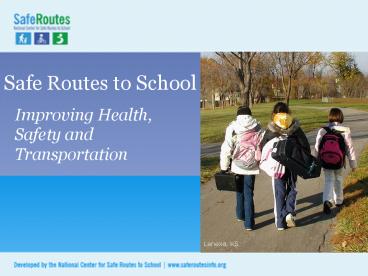Safe Routes to School - PowerPoint PPT Presentation
1 / 28
Title:
Safe Routes to School
Description:
Fewer kids today walk and bike to school. Unintended consequences have ... It takes about 10 minutes to walk a quarter of a mile or bike an entire mile (PFOA) ... – PowerPoint PPT presentation
Number of Views:130
Avg rating:3.0/5.0
Title: Safe Routes to School
1
Safe Routes to School
- Improving Health, Safety and Transportation
Lenexa, KS
2
The need for Safe Routes to School
- Fewer kids today walk and bike to school
- Unintended consequences have resulted
- SRTS programs are part of the solution
3
1. Fewer kids are biking and walking. More
parents are driving.
- 2001 16 walked
- 1969 42 walked
- (CDC, 2005)
- Parents driving children to school
- 20-25 of morning traffic
4
What caused the shift?
5
School siting issues A generation ago
- Small schools
- Located in community centers
- (EPA, 2003)
6
School siting issues Today
- Mega-schools
- Built on edges of towns and cities
School consolidations have lengthened the trip
between home and school
School consolidation has lengthened the trip
between home and school
School consolidations have lengthened the trip
between home and school
7
Its not just distance
- Students who live within 1 mile and walk or
bike - 2001 63
- 1969 87
- (CDC, 2005)
8
Most common barriers to walking and bicycling to
school
- Long distances 62
- Traffic danger 30
- Adverse weather 19
- Fear of crime danger 12
- Note Sum of percentages is more than 100
because respondents could identify more than one
barrier. - (CDC, 2005)
9
Traffic danger
10
Adverse weather
Howards Grove, WI
Centreville, VA
11
Individual community issues
- Fear of crime (both real and perceived)
- Abandoned buildings
- Other reasons
12
2. What are the unintended consequences of less
walking and bicycling?
- For individual health
13
Physical inactivity
- Most kids arent getting the physical activity
they need - Recommended 60 minutes on most, preferably all,
days of the week - (US Depts. of Health and Human Services and
Agriculture, 2005)
14
Obesity Trends Among U.S. AdultsBRFSS, 1990,
1995, 2005
(BMI ?30, or about 30 lbs overweight for 54
person)
1995
1990
2005
No Data lt10 1014
1519 2024 2529
30
15
Obesity Trends Among U.S. AdultsBRFSS, 2006
(BMI 30, or 30 lbs. overweight for 5 4
person)
lt10 1014
1519 2024 2529
30
16
U.S. youth overweight rates
- (National Center for Health Statistics)
17
South Dakota School Height and Weight 2005-2006
School Year
18
Overweight children have an increased risk of
- Type 2 Diabetes
- Low self esteem
- Decreased physical functioning
- Obesity in adulthood
- Many other negative emotional physical effects
- (Institute of Medicine, 2005)
19
3. Safe Routes to School programs are part of the
solution
- ...to improve walking and bicycling conditions
- ...to increase physical activity
Dallas, TX
20
More benefits of SRTS programs
- Reduce congestion around schools
- Encourages community unity and involvement
- Increase childs sense of freedom, help establish
lifetime habits, teach pedestrian and bicyclist
skills
21
Elements of SRTS programs
- Education
- Encouragement
- Enforcement
- Engineering
- Evaluation
Lenexa, KS
22
Education
- Imparts safety skills
- Creates safety awareness
- Fosters life-long safety habits
- Includes parents, neighbors and other drivers
Chicago, IL
23
Encouragement
- Increases popularity of walking and bicycling
- Is an easy way to start SRTS programs
- Emphasizes fun
Elmhurst, IL
24
Enforcement
- Increases awareness of pedestrians and bicyclists
- Improves driver behavior
- Helps children follow traffic rules
Richmond, VA
Denver, CO
25
Engineering
- Creates safer conditions for walking and
bicycling - Can influence the way people behave
West Valley City, UT
26
Evaluation
- Is the program making a difference?
27
Safe Routes to School goals
- Where its safe, get children walking and biking
- Where its not safe, make changes
Winston-Salem, NC
28
South Dakota Safe Routes to School
- Angela Olson
- Safe Routes to School Coordinator Department of
Transportation - Angela.olson_at_state.sd.us
- 605-773-2402
- www.sddot.com/srts/
- Online March 3rd
- National Center for Safe Routes to
Schoolwww.saferoutesinfo.org
29
Statistics
- A pedestrian struck by a car traveling at 40 mph
has a 15 percent chance of survival. At 30 mph
there is a 55 percent chance of survival. At 20
mph there is an 85 percent chance of survival
(U.S DOT) - Seventy-three percent of children between 5 and 9
years old killed in accidents were riding in cars
(NHTSA) - Forty-six percent of traffic crashes involving
kids as pedestrians occur when a child darts out
into the street (NHTSA) - Fifty percent of children who are hit by cars
near schools are hit by cars driven by parents of
other students (WSDOT) - Less than 1 percent of children aged 7-15 now
ride bicycles to school, a decrease of more than
60 percent since the 1970s (Surface
Transportation Policy Project, Caught in the
Crosswalk) - Sixty-one percent of adults would walk more if
they had safe, secure paths (Pedestrian
Federation of America) - It takes about 10 minutes to walk a quarter of a
mile or bike an entire mile (PFOA) - Traffic Calming reduces collision frequency by 40
percent, vehicle insurance claims by 38 percent,
and traffic fatalities by 50 percent (Insurance
Company of British Columbia)































